The Jubilette was made by the Balda Werke of Dresden, Germany, around 1938. Its name refers to the 30-th anniversary of Balda's existence (the company was started by the 21-year old Max Baldeweg in 1908).
This was an economy model in the company line-up, well below the Baldina or Super-Baldina of 1936. It was not special in any respect, just another working camera, and it does not seem to be a collector's item, so it may be a good choice as a starting point of your camera collection, or as a conversation item added to your existing one at a modest expense ($50 or less).
Actually, sometimes I suspect that some people do not collect old cameras, as hard it may be to believe...
|
I liberated this particular one from a second-hand camera store in Lodz, Poland. They didn't have any Exakta bodies of lenses, and I had that itch...
The Jubilette is a folding compact model, using the standard 35-mm film. You could actually carry it in your pocket.
The viewfinder is small and ugly, and this is perhaps the only thing I really dislike about this camera.
|
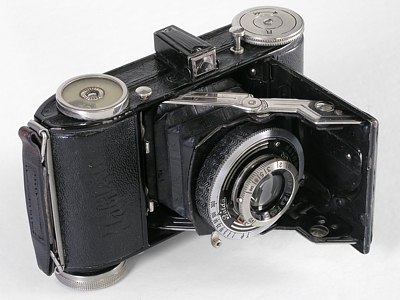
Camera s/n 3940339, lens s/n 417963
(All pictures taken with the Olympus C-5060WZ)
| |
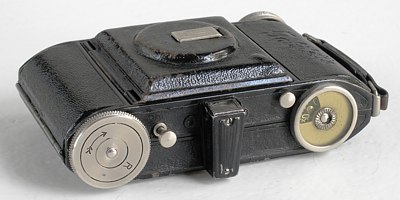
|
What you see prominently on the camera's top is the rewind knob (marked 'R'); film winding is done with a thicker knob at the bottom.
The left (more protruding) button is the shutter release (left-handed, which was not so uncommon those days); the one at the right opens the camera front, moving the lens into working position.
|
|
This spring-driven process ends with a satisfactory, reassuring thud, with the steel struts providing good dimensional stability even now, almost 70 years later.
Note the small leg, flipping out from the front cover; this nifty gizmo was almost standard on folding cameras those days: a mini-tripod (almost) when you need it.
To close the front, take the camera in both hands, vertically and with the lens facing away from you, then use your thumbs to press down the "elbows" of the shiny steel struts. Once the front cover moves from the open position, you will be able to close it all the way.
This is something I've learned at the age of five, having opened my father's 6×9 cm folding Beirax, and being unable to close it back — at least I was smart enough not to apply excessive force, so no harm was done!
|
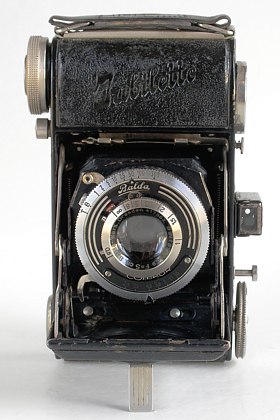
|
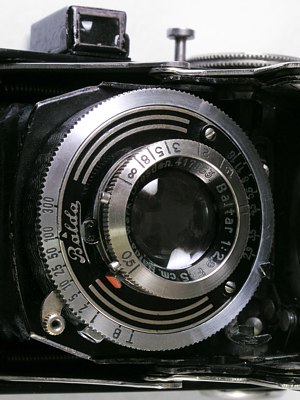
|
My Jubilette carries a 50 mm F/2.9 Baltar lens, but some used other lenses; see the specs below.
All camera controls are visible here, placed on the lens itself: the focus ring (with the minimum distance of 0.5 m), shutter speed dial, and the triangular aperture control tab, placed in a most inconvenient fashion. (It was really the Japanese who invented camera ergonomics.)
Well, this is all we need to take pictures: focusing, shutter, and aperture — plus a working brain. I've never used the Jubilette for this purpose, but know of some people who did, and with nice results.
Next to the shutter scale you can see the shutter-cocking lever, discussed further down.
|
|
With the camera back open, we can see the film path; nothing unusual in today's standards. The camera uses the same film cartridges as the current 35-mm models do.
The longevity of this standard is quite amazing; if not for digital, we would be still using it twenty years from now!
As you can see (check the full-size image), the film path did not survive all those years unscathed; my Exaktas of the same period look much better.
|
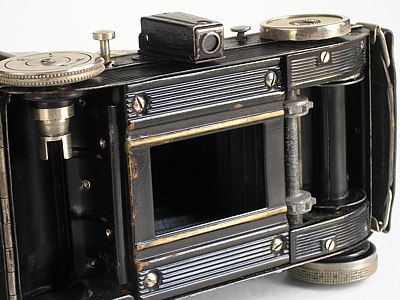
|
Film advancing is done with the big knob at bottom right of the picture above; next to it sits the button which has to be pressed when you start the operation (visible in other pictures, but not here). It is easy to take this button as a rewind one (a more common solution in later cameras); to allow for film rewind, you have to pull the wind knob out.
Winding the film to the next frame does not cock the shutter; you have to do it manually with a small lever (see the lens picture). The T and B settings do not require shutter cocking. It is easy to take multiple exposures on the same frame, intentionally or not: just keep shooting without advancing the film.
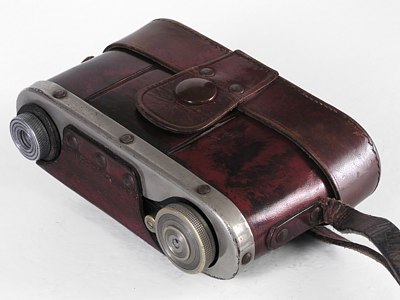
|
This Jubilette came with a matched leather ever-ready case with a sheet metal (!) bottom, providing access to the film wind knob and button. The case is made better than most I've seen.
Other Jubilette cases I've seen used a more traditional "purse" design; it is unclear if mine was sold as an extra.
| |
Various versions
I have seen a number of variants of this camera. Just as examples:
-
No Balda logo on the lens mount; F. Deckel Muenchen instead (F. Deckel was the maker of Compur shutters). This variant also uses a folding key instead of a round knob for rewinding; this looks like a more modern solution. An example can be found at Xylocopal's page; it has a Meyer Trioplan lens.
After World War II the Balda Werke in Dresden (utterly destroyed by the Allied bombings) was nationalized; Max Baldweg fled to (what became later) West Germany, where he started a company under the same name, making cameras for another twenty five years. Is it possible that these cameras were made by the reincarnated Balda?
-
Balda logo present, but a folding key for rewind (plus an external spring plate underneath the rewind button; same as in the previous model). This is the model shown by Veijo Vilva, and it uses the Friedrich Corygon lens.
-
F.Deckel logo, but no external spring plate; Schneider-Kreuznach lens — as shown in Kevins Camera Collection.
Unfortunately, most of the Jubilette pictures I've seen on the Web are in low resolution, and also quite unsharp, so checking the detail is close to impossible. (One more reason to click on the images shown here.)
Camera specs at a glance
This is what you could expect from a basic (but by no means cheap) camera in those years.
-
Shutter: Compur in-lens; 1s to 1/300s plus B and T. Cranked manually.
-
Lens: Uncoated Baltar, 50 mm F/2.9; focusing from .5 m, apertures up to F/16.
While my Jubilette came with this lens, I've seen others:
-
Friedrich Corygon-Anastigmat 50 mm F/2.9
-
Meyer Trioplan 50 mm F/2.9
-
Schneider-Kreuznach Radionar 50 mm F/2.9
I'm not sure if Balda had lens manufacturing capacity; also note that all these lenses have the same maximum aperture of F/2.9 (not a single 2.8 or 3.5); therefore I suspect that at least some of these were re-branded clones, made either by Meyer (Goerlitz) or by E. Ludwig (Dresden), both having a tradition of making lenses under someone else's names. On the other hand, Schneider is a pREMum brand, so I would think that lens is genuine and different than the others.
Friedrich was a small lens maker based in Munich, and my guess (which can be wrong) is that they may have joined the post-war production only.
-
Flash synchronization: none.
-
Viewing: a Newtonian viewfinder; no rangefinder.
-
Self-timer: no.
-
Film transport: winding knob, rewind crank, wind-activation button; no auto shutter cocking, no provision against unintentional double exposures.
-
Film loading: hinged back with a lock.
Web resources
As I said, Jubilette is not a collector's camera, therefore there are not many Web sources available on it. Here is what I was able to find.
-
A version with the Corygon lens is shown at Veijo Vilva's 35-mm Folders page, together with examples of pictures taken with this camera.
-
A Jubilette page [2018: link dead!] at the Xylocopal's Jewels of Nostalgia; while the site is in Japanese, the pictures speak for themselves.
|


